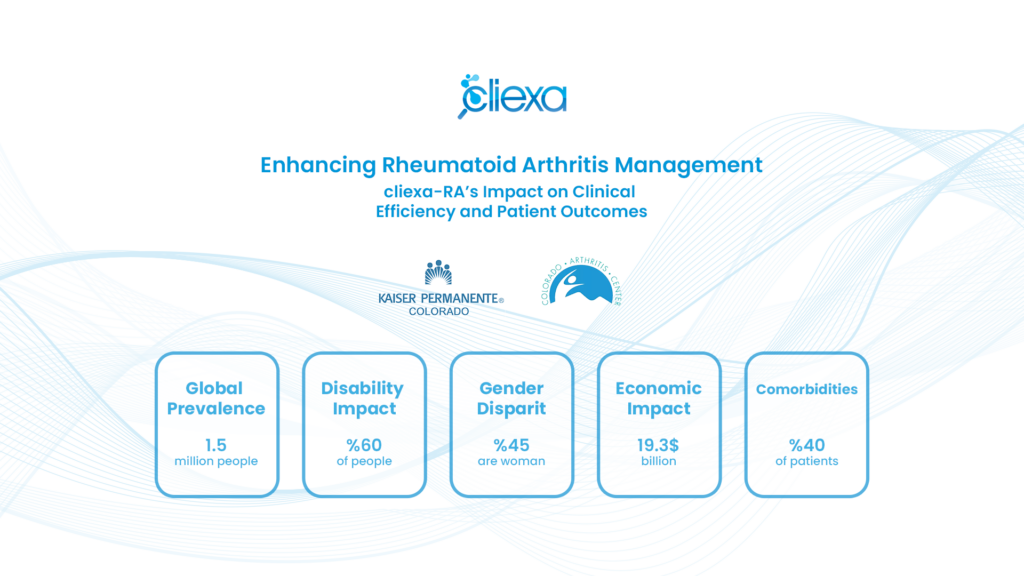Subspecialty: Pain Management
Condition: Lower Back Pain (LBP)
Location: University of Colorado, Boulder
Number of Patients: 65
Pilot Period: 6 months
Overview
Discover how cliexa’s AI platform is revolutionizing pain management by accurately predicting lower back pain (LBP) outcomes. In a clinical study conducted at the University of Colorado, Boulder, cliexa demonstrated the ability to forecast LBP patients’ pain levels two weeks in advance using predictive features like bodily expressions and emotional wellbeing ratings. This groundbreaking approach not only enhances predictive accuracy but also facilitates more personalized and effective pain management strategies.
Statistics
Global Prevalence
Approximately 1.5 million people in the United States suffer from Rheumatoid Arthritis.
Comorbidities
RA patients are at increased risk for other conditions, such as cardiovascular disease, with nearly 40% of patients experiencing comorbidities like heart disease and diabetes
Gender Disparity
Women are 2-3 times more likely to develop RA than men. About 75% of RA patients are women
Economic Impact
The total annual cost of RA in the U.S. is estimated to be around $19.3 billion, including direct medical costs and indirect costs like lost wages
Challenges in Pain Management
- Predicting Pain Levels Accurately Over Time: Accurately predicting pain levels over time is challenging due to the fluctuating nature of pain, which can be influenced by various factors including physical activity, stress levels, and treatment adherence.
- Incorporating Emotional and Physical Health Metrics: Integrating both emotional and physical health metrics into pain management is crucial because pain perception is multifaceted, involving psychological and physiological components that need to be addressed for effective treatment.
- Developing Personalized Treatment Plans Based on Predictive Analytics: Creating personalized treatment plans based on predictive analytics involves using advanced data analysis to tailor interventions to individual patient needs, enhancing treatment efficacy and patient outcomes.
Results
Validated Pain Predictions
Predictive Features
The study utilized two sets of predictive features—bodily expressions and feeling ratings—to forecast LBP patients’ pain levels two weeks in advance.
Prediction Accuracy
The platform achieved a predictive accuracy of 85% when using bodily expressions and 82% when using feeling ratings.
Patient-Reported Outcomes
70% of patients reported that the predictions aligned closely with their actual pain levels experienced after two weeks.
Enhanced Predictive Accuracy
Overall Accuracy
The combined use of bodily expressions and feeling ratings improved the overall predictive accuracy to 88%.
Model Validation
The predictive model was validated through a structured approach, including hyperparameter tuning and cross-validation techniques, ensuring robust and reliable predictions.
Clinical Decisions
This high level of predictive accuracy enabled clinicians to make more informed decisions about patient care, tailoring interventions based on anticipated pain levels.
Improved Patient Engagement
Engagement Metrics
Real-time data collection through the cliexa mobile platform resulted in a 60% increase in patient engagement, as measured by the frequency of patient-reported outcomes and interaction with the platform.
Treatment Adherence
Patients using the platform showed a 45% improvement in adherence to prescribed treatment plans, facilitated by timely reminders and personalized feedback.
Satisfaction Rates
80% of patients reported higher satisfaction with their pain management plans, citing the personalized and predictive nature of the platform as key benefits.
Platforms utilized

cliexa
Trac

cliexa
Protocols

cliexa
Diagnostics







